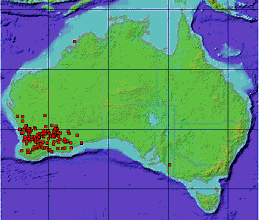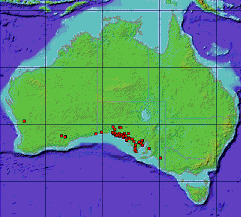Other names:
Porcupine SolanumSummary:
Afghan Thistle is a very prickly, sprawling, colony forming herb with perennial underground stems. It has a somewhat annual top to 30 cm high, with many spines to 15 mm long on the stems, leaves and the calyx. The leaves are 3-15 cm long, shiny, yellow-green and deeply lobed, with simple and gland-tipped hairs as well as the yellow spines. The flowers are pale blue or white and 1.5-3 cm across with yellow anthers from January to March and September to November. The berry is globular, 1.5-2 cm across, at first green but turning black at maturity and mostly hidden by the enlarged prickly calyx.Description:
Cotyledons:Leaves:
Alternate.Stems:
Low lying, branching, rigid, 100-350 mm long. Many yellow, straight 10-14 mm long spines. Tend to be annual. Almost hairless on Solanum hystrix. Solanum hoplopetalum is bristly hairy with simple, several-celled hairs.Flower head:
1-5 flowered cyme on a prickly stalk(peduncle) with the flowers also on prickly stalks(pedicels).Flowers:
Ovary -Fruit:
Black, soft, juicy berry, slightly flattened globular, 15-30 mm diameter. Yellowish green turning brown to purple when ripe. Initially enclosed in a prickly membranous coat(calyx) and later protruding from it. In S. hoplopetalum the fruit does not protrude from the calyx.Seeds:
Dark grey, flattened, egg-shaped to kidney-shaped, 25mm long.Roots:
Strong taproot to 1000 mm deep. Network of brittle horizontal laterals up to 10 mm thick about 100-200 mm below ground.Key Characters:
Prickles present on branches, leaves and calyx.Biology:
Life cycle:Physiology:
Reproduction:Flowering times:
January to March and September to November in WA for Solanum hoplopetalum.Seed Biology and Germination:
Vegetative Propagules:Hybrids:
Allelopathy:Origin and History:
Australia.Distribution:
SA, WA. May be VIC also.

| Solanum hoplopetalum distribution. | Solanum hystrix distribution. |
Habitats:
Favours lighter soils and fallowed land in the 200-700mm rainfall zone. Occasionally found on clay soils.Climate:
Temperate. Mediterranean.Soil:
Mainly on sandy soils and occasionally on clays.Plant Associations:
Significance:Beneficial:
Aboriginal food, the fleshy centre is scraped out and eaten.Detrimental:
Weed of crops, pastures, roadsides , railways, fallows, open woodlands and disturbed areas.Toxicity:
Not recorded as toxic.Legislation:
Noxious weed in WA.Management and Control:
Cultivations starting in October to November when the plant is starting to grow and repeated as necessary to prevent flowering and exhaust the rootstock provides eventual control. Patches should be treated individually to prevent contamination of clean areas. It is relatively tolerant to hormone herbicides. Picloram and glyphosate have some action at higher rates.Thresholds:
Eradication strategies:Herbicide resistance:
Biological Control:Plants of similar appearance:
References:Acknowledgments:
Collated by HerbiGuide. Phone 08 98444064 or www.herbiguide.com.au for more information.